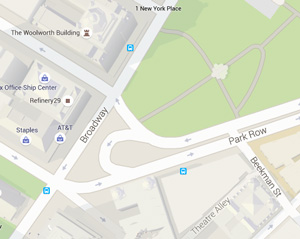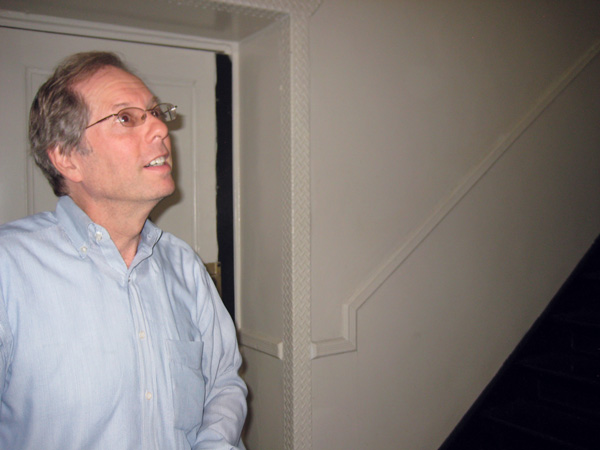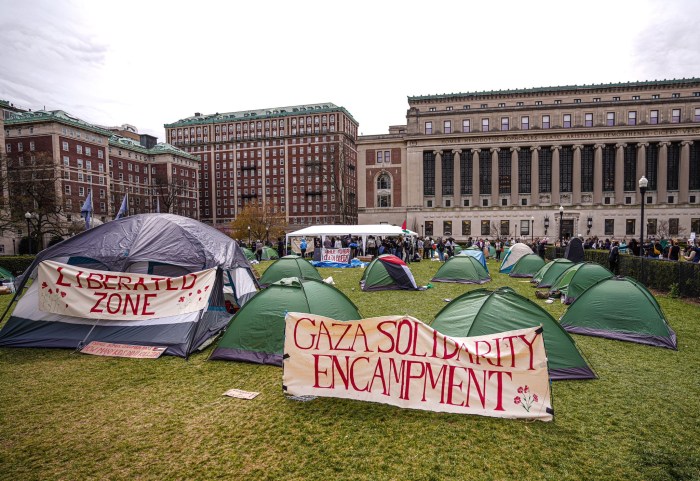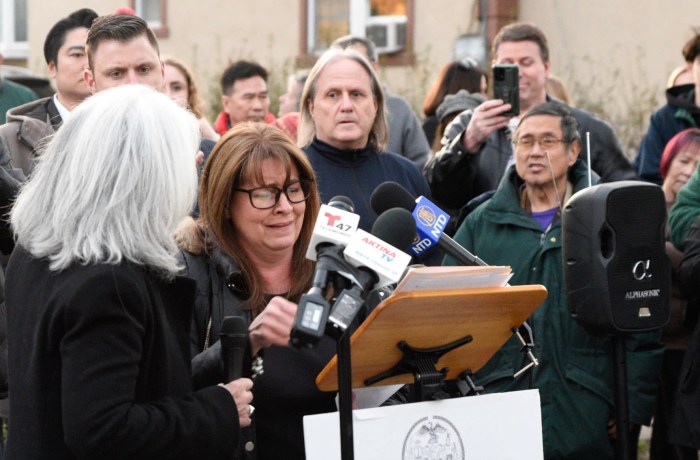
Above, 34 Park Row on the corner, and 33 Park Row next to it will make way for a new building. Below left, a photo of a younger Alan Steinberg in front of Park Row.

BY DUSICA SUE MALESEVIC | Alan Steinberg has seen Park Row change.
He has seen the block from Ann to Beekman Sts. in the Financial District go from drug dealer terrority to a retail and restaurant haven to J&R Music World’s domain to now turning residential.
The story begins with Steinberg’s father, an accountant who had a client on Park Row in the 1960s — Emil’s Restaurant, a place Steinberg says was frequented by mayors.
In 1970, his father along with other investors rented the entire building at 34 Park Row, also known as 1 Beekman St., with the option to buy, Steinberg said in a interview at his office at 116 Nassau St.
At that time, 34 Park Row was an empty building.
He also started a company, Park Row South Realty, which Steinberg, 56, is now president of. Six years later, his father with the syndication brought 34 Park Row and the building next to it, 33 Park Row.
“We were not wealthy,” he explained last week. “My father put together a number of his clients, associates, friends [and] family. Everybody put together money and bought these empty buildings.”
He bought 33 Park Row — a decision Steinberg’s mother didn’t think was a great idea — because it was not empty, it had a tenant. That tenant was J&R Music World, which had its first store there in 1971.
 His father invested in the buildings because as an accountant, “he could only make as much money as the pencil that he pushed. He was looking for retirement income that hopefully, eventually he would rent it out and pay off the mortgage,” said Steinberg.
His father invested in the buildings because as an accountant, “he could only make as much money as the pencil that he pushed. He was looking for retirement income that hopefully, eventually he would rent it out and pay off the mortgage,” said Steinberg.
In the ‘70s, when Steinberg was growing up on Long Island, Park Row had a lot of crime in the area — there was a lot of drug dealing in Theatre Alley, the street that is behind the block.
Steinberg’s father also faced new competition — the Twin Towers.
“Any tenant who was worth anything in the 1970s would be running to the World Trade Center,” he said. “Everybody wanted to get an office there. His idea was to have small offices, small little niches for small little tenants who couldn’t get an office there.”
However, the year after his father brought the buildings, he passed away at the age of 53. His mother, who was a Hebrew schoolteacher, was advised not to sell and the buildings were handed over to people to manage.
“After my father died, it actually turned me off — I wanted nothing to do with it,” he said.

Alan Steinberg in the now empty building at 34 Park Row.
Steinberg got a master’s degree in finance from Hofstra University and went to work on Wall Street as a commodity trader. In 1987, he was ready to branch out and start his own trading company. His mother suggested he base his operations in one of their buildings. In exchange for rent, he would take over managing them.
It was hard to do both at the same time, he said. He said the buildings were being mismanaged and a management agent was stealing. He asked his mother to take over and then went to New York University to take some real estate classes.
“I then started a process of buying out my dad’s investors,” he said.
He brought his own team in and while it wasn’t big business, the buildings turned profitable.
Park Row started getting better and J&R was expanding — it had other stores on the block.
“In the 1980s, as J&R was growing, Park Row started coming alive,” he said. “Any retail store that became available on Park Row, J&R was grabbing it.”
Steinberg remembers what was on the block — two hardware stores, a jewelry store, a Radio Shack, a Burger King and an optometrist. Several would turn into J&R stores.
“They were successful and they had cash and they bought the buildings,” he said. “Their main concern was retail. They wanted to be like Harrods or Macy’s. They wanted to be block to block.”
In the ‘90s, that is almost what happened — with only one store holding out.
“Once J&R got 34, now they could say, ‘We had the entire block’ — from 34 Park Row to 1 Park Row,” said Steinberg.
There was an unofficial sign that said “J&R Row,” he said. The store’s owners did not respond to a request for comment.
At that time, “nobody was looking to move down here,” he said. “This place shut down for the weekends. It shut down at 6 o’clock at night.”
The area was so quiet, he noted, that when he left late at night he wouldn’t take the subway to his apartment on the Upper West Side — no one was around.
Then Sept. 11, 2001 happened.
Steinberg wasn’t there that day, but he remembers where he was the day after — the authorities allowed him into his buildings, which were completely engulfed by dust fumes. Except for being dirty, they were not damaged and Steinberg said that he didn’t lose any tenants.
J&R had closed for a while but had a grand reopening with then Mayor Rudy Giuliani, he said.
For Steinberg, business after Sept. 11 began getting better.
“We never really had a vacancy issue — there’s always somebody looking for small office space,” he said, citing inexpensive rent with park views as the reason. “We never were empty.”
J&R, which had become a popular destination store, continued to grow and Steinberg said they would “take any space I had.”
“As a landlord in New York, if your long-term tenant continues to pay and you continue to see full page ads in the New York Times, there’s no reason to believe that there is any issue,” he said.
J&R is a private company with an excellent reputation, he said. Steinberg also had a personal relationship with Rachelle Friedman. She and her husband Joe had started the business.
So in 2013 when J&R wanted to end their lease — Steinberg was stunned.
“I really felt that they were the Rock of Gibraltar and if they weren’t for the city of New York, they certainly were for my family,” he said.
(The J&R store at 1 Park Row closed in April 2014, but their signage is still on several buildings on the block. J&R Express is now open inside Century 21.)
For four months he couldn’t tell his wife or mother. During that time, he considered the residential route and hired an architect.
“The residential wave that had now hit Tribeca was now starting to overflow to the Financial District,” he said.
After exploring that option, he said he decided to partner with a developer.
In December last year, real estate company Urban Muse reportedly bought 33 and 34 Park Row for $52 million.
Both 33 and 34 Park Row will be demolished to make way for a mixed-use building — called “Pearl on the Park” — with condos on the upper levels and retail on the lower levels, said Steinberg.
“Pearl is my mother’s name,” he said. “I wanted my mother to see what my father’s vision would become.”
It is expected to be open in 2017, but no details yet on how tall it will be. Steinberg declined to discuss the sale.
Steinberg now had the task of vacating 34 Park Row, a building that had been in his family since the ’70s. Some tenants had been with his family for decades, he said.
He made an unusual move — instead of the 1,500 sq. ft. he needed for his office, he decided to rent 11,000 sq. ft. at 116 Nassau St. and offer the space to his tenants. Almost all — except for two or three — took him up on it.
Steinberg proudly showed the new offices, where work was still being done, and introduced Downtown Express to tenants, like Al Maddox of Maddox Watch Co. With a loupe on his head, Maddox and Steinberg explained how he started his business in December 1949 at 116 Nassau St. on the eighth floor — where the offices are now located.
Chris Rohan, a metal trader, has been Steinberg’s tenant for seven years.
“Small space is hard to find — everything is too big,” Rohan said.
Steinberg also showed the now empty 34 Park Row. On the roof of the building, the view encompasses City Hall to the right, the park to the center and the World Trade Center PATH station to the left. Construction went on at nearby 5 Beekman St., which will be condos and a hotel.
It seems that Park Row is poised for another transformation.

















